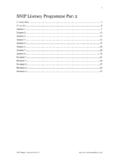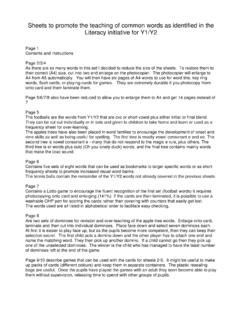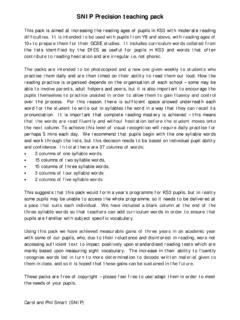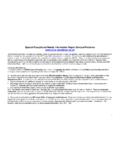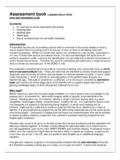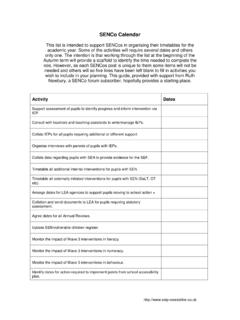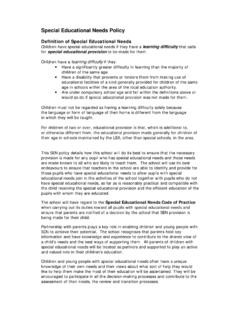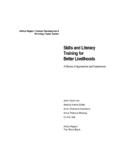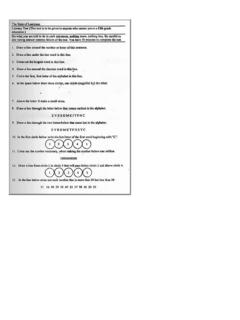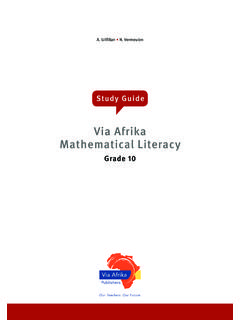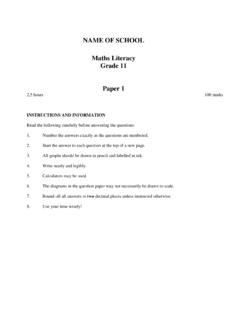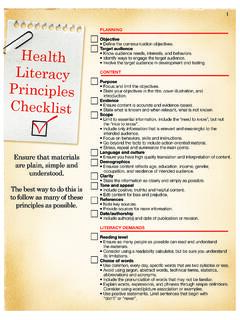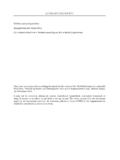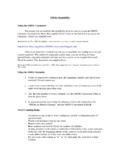Transcription of SNIP Literacy Programme 1 Introduction
1 SNIP Literacy Programme 1 IntroductionPhil and Carol Smart are both qualified dyslexic tutors. They were both classroom teachers for many years before specialising in addressing the barriers to learning experienced by children and young people. Together they have taught many hundred of pupils who struggled with Literacy and during this time, have used a wide range of different interventions to promote success. The need to locate a Programme that was the best fit in meeting the needs of pupils with Literacy difficulties, resulted in development of a resource that: Had a rapid success rate. Was practical in its delivery. Was enjoyed by pupils. What is the Programme ?
2 The Programme is aimed at increasing reading and spelling and uses the primary high frequency words (HFW). These words are grouped by selecting those that visually look different to each other. It is felt that this Programme is appropriate for pupils of 8+ with standardised Literacy scores of 80 or less, who have already been exposed to effective phonic/ Literacy teaching but are still struggling. The Programme approaches Literacy acquisition at the word level and addresses the gaps in phonics knowledge through the application of analytic phonics (drawing pupils attention to the make up of words as they break up the target word). What is its rationale?
3 Our experience as dyslexic tutors has taught us that: Many pupils who required support were already familiar with sound/symbol relationships. They could say the sound represented by symbol, although often struggled with more complex diagraphs and were unable to blend the individual sounds into a word or pronounce it correctly. Some of these difficulties appeared to be related to underlying depleted auditory skills in perception, discrimination, memory etc. Phonic programmes were the most common strategy that had been used to remediate their Literacy deficits. We wanted something that was different and had quick and measurable results to persuade pupils it was worth giving a try!
4 Structured and cumulative phonic programmes take a long time to have an impact on reading and spelling accuracy. This rate of improvement is not likely to have a positive impact on a pupil s self esteem. The SNIP Programme provides a high level of over-teaching absolutely key to ensuing recognition and fluency. We grouped words so that they were not phonically similar. When we were originally using phonic groupings, our pupils quickly learned that they only had to listen for the first sound and then copy the rest of the word as in, night, right, light etc no useful learning was taking place there. We remain grateful for all that our pupils taught us!
5 Our time with pupils was often short. For the majority we spent 1 x 40 mins a week with them. If their needs were substantial, then for a few we had 2 x 40 mins this was in the main for pupils with statements who were performing on the first percentile. This is very little time to improve Literacy , particularly if the problems were in both reading and SNIP Literacy Programme 1 Comparisons of interventions often measure progress over the short term. This can be misleading as often the initial improvement is not be maintained. Records using the SNIP Programme indicate that over a 4 year span the average improvement for all pupils was slightly more than 10 months a year in spelling and months in reading.
6 This included the pupil with the most significant need (statement for significant learning difficulties) who averaged mths a year in spelling and 4 mths a year in reading and the most improved pupil who averaged 14 mths a year in spelling and 19 mths a year in reading. Delivery The Programme needs to be delivered at one pack each week slower than this and progress will be not sufficient to ensure increased levels of progress. It could be delivered: In a single session at least 40 mins, but great care needs to be taken with this. Most pupils will need the over-learning necessary to make sure the spelling are automatically recalled and this means that in addition to the 40 mins they also need 10 mins twice a week to go over the words.
7 (WordShark is ideal for this just put the target words in and the software Programme will jumble them up into games) The accurate answer to how much time is required, is probably sufficient to ensure that a whole section is completed and that 100% accuracy in reading and 90% accuracy in spelling is achieved when success is assessed at the end of the week. This is likely to be different for each pupil. As shorter sessions (say 10 mins each day) but this needs to be undertaken every day. Who can deliver it? Anyone who is experienced in teaching pupils who have learning difficulties so they can point out strategies to support learning through highlighting the chunks in a word, linking phonic knowledge and/or using mnemonics.
8 Where do you start? With most pupils start at the beginning. Ask the pupil to first read and then spell the words and mark their levels of accuracy. There is a checklist provided to help you record this. Their results are shared with them so that they can see their own success and understand their efforts have led to this progress. This is not a done-to Programme . Many pupils have become over-placid and reliant on support they just hope that someone is going to come and cure them. They need to link their own efforts to progress our job is to provide them with the tools to do so the effort is theirs and so is the resultant improvement. What does the primary pack contain?
9 The 25 packs include words taken from the National Literacy Strategy High Frequency word lists (YR, Y 1/Y2 and Y4/Y5). Each pack targets 9 words and has 3 A4 pages with 6 exercises: Look, say, cover, write and check Tracking Anagrams Fill in the missing letters/words Crossword and with reading the words out loud shared reading linking with words already known. Explain the vocabulary and encourage the pupil to put the word in a sentence. Then the pupil reads out the words independently but help is provided if necessary. They SNIP Literacy Programme 1 to be familiar with the words before they start to learn to spell them. , say, cover, write and check in the first column, one word at a time if they make an error examine where it went wrong, emphasising the letters they have placed in the right place and try again.
10 The extra columns are provided so LSCWC can be completed again preferably daily. The words are written in the letter sequence twice. So the pupil would say out loud can c-a-n (We have no issue if they say the name or the sound of the letter as it is the sequence that is important) Then they place their pen under the first letter, in this case s , and draw a line underneath the letters until they come to the c they loop over this letter then go onto find a etc. Each time they loop a letter they say it out loud. The word is hidden twice in the line. They complete the rest of the column. Other exercises may include: Anagrams reordering the letters to link the word and write it on the line again saying it out loud to rehearse the sequence of the letters.
